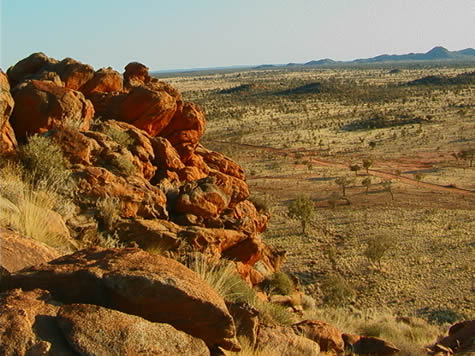Wednesday 2001 August 29. North of Claraville Homestead.
Having passed the ‘Huckitta’ Station turn off earlier in the day, it was interesting to learn that the foothills we are now entering is called a Huckitta Land System.
“The Huckitta Land System of rugged limestone ranges in the central part of Australia covers about 1600 square kilometres. Its steeply dipping and often contorted limestone hills reach a height of up to 225 metres.”

Climbing a few of these rocky hillocks yesterday evening gave a terrific demonstration of how the aspect (direction a slope faces in relation to the sun) even of small dry hillocks, impacts the vegetation which will grow there. The sunny side of a hill (in Australia this is the north) is hotter and drier than the slope which is shaded during midday heat. This is true for mountains thousands of metres high, right down to large boulders on relatively flat land. Liverwort will assert itself on the hospitable side of a rock only, and it is possible to find direction by observing this.
The shaded side of a slope causes a number of environmental conditions to vary. Some of the most noticeable include the amount of precipitation received, the change in humidity levels, the temperature difference, and the amount of solar energy available. Different plants thrive under these different conditions.
Over many years, larger amounts of water and sunlight have an effect on soil composition, by encouraging organic matter to grow and break down in the earth, enriching it, and increasing the variety of plants able to grow in those areas.
Think about how your household’s food scraps (organic waste) is disposed of. If you have a garden, suggest to your parents that you begin composting. If you have a compost heap already, find out how it works, and who maintains it. Adding compost to your garden will allow you to grow plants including vegetables which otherwise would not thrive in the same space.
bel.